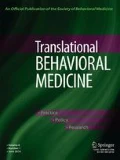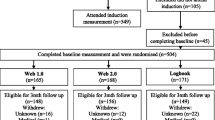ABSTRACT
New evidence-based physical activity and sedentary behavior guidelines for Canadians were launched in 2011. As a consequence, service organizations that promote physical activity directly to the public needed to change their promotion materials to reflect the new guidelines. Little is known about the rate at which service organizations adopt and integrate new evidence-based guidelines and determinants of guideline adoption. In this natural observational study, we evaluated the rate of online adoption of the new guidelines among key service organizations that promote physical activity and examined participation in a booster webinar as a supplemental dissemination strategy. One hundred fifty nine service organization websites were coded by one of six raters prior to the release of the new guidelines as well as at 3, 6, and 9 months after the release. Online adoption of the guidelines increased during the coding period with 51 % of organizations posting the guidelines or related information on their websites. Organizations’ engagement in a webinar was associated with their adoption of the guidelines. The release of new Canadian Physical Activity and Sedentary Behaviour Guidelines led to increased guideline adoption on service organizations’ websites. However, adoption was not universal. In order for the uptake of the new guidelines to be successful, further efforts need to be taken to ensure that service organizations present physical activity guidelines on their websites. Comprehensive, active dissemination strategies tailored to address organizational barriers are needed to ensure online guideline adoption.
Similar content being viewed by others
References
Warburton DE, Charlesworth S, Ivey A, Nettlefold L, Bredin SS. A systematic review of the evidence for Canada’s Physical Activity Guidelines for Adults. Int J Behav Nutr Phys Act. 2010;7:39.
Tremblay MS, Colley RC, Saunders TJ, Healy GN, Owen N. Physiological and health implications of a sedentary lifestyle. Appl Physiol Nutr Metab. 2010;35(6):725-740.
Bellew B, Schoeppe S, Bull FC, Bauman A. The rise and fall of Australian physical activity policy 1996–2006: a national review framed in an international context. Aust New Zealand Health Policy. 2008;5:18.
Tremblay M, Haskell WL. From science to physical activity guidelines. In: Bouchard C, Blair SN, Haskell WL, eds. Physical Activity and Health. 2nd ed. Champaign, IL: Human Kinetics; 2012.
Faulkner G, McCloy C, Plotnikoff RC, et al. ParticipACTION: baseline assessment of the capacity available to the ‘New ParticipACTION’: a qualitative study of Canadian organizations. Int J Behav Nutr Phys Act. 2009;6:87.
Plotnikoff RC, Todosijczuk I, Faulkner G, et al. ParticipACTION: baseline assessment of the ‘new ParticipACTION’: a quantitative survey of Canadian organizational awareness and capacity. Int J Behav Nutr Phys Act. 2009;6:86.
Rogers EM. Diffusion of innovations. 5th ed. New York, NY: Free Press; 2003.
Greenhalgh T, Robert G, MacFarlane F, Bate P, Kyriakidou O. Diffusion of innovations in service organizations: systematic review and recommendations. Milbank Q. 2004;82(2):581-629.
Tremblay MS, Warburton DE, Janssen I, et al. New Canadian physical activity guidelines. Appl Physiol Nutr Metab. 2011;36(1):36-46.
Tremblay MS, LeBlanc A, Janssen I, et al. Canadian sedentary behavior guidelines for children and youth. Appl Physiol Nutr Metab. 2011;36(1):65-71.
Canadian Society for Exercise Physiology. Canada’s physical activity guide—synthesis of substantive content for the guide based on the scientific review process. Document summary in preparation of Canada’s Physical Activity Guide for Healthy Active Living. 1996; http://www.csep.ca.
Brownson RC, Ballew P, Brown KL, Elliott MB, Haire-Joshu D, Heath GW, Kreuter MW. The effect of disseminating evidence-based interventions that promote physical activity to health departments. [Multicenter Study Research Support, U.S. Gov't, P.H.S.]. Am J Public Health. 2007;97(10):1900–1907.
Latimer AE, Murumets K, Faulkner G. ParticipACTION: the national voice of physical activity and sport participation in Canada. In: Marcus B, ed. The American National Physical Activity Plan. Champaign, IL: Human Kinetics; 2013, In Press.
Latimer-Cheung AE, Tomasone JR, Rhodes RE, et al. Developing evidence-based messages for translating physical activity guidelines into practice. Ann Behav Med. 2012;43(1):s93.
Multiple-Rater Kappa Statistic Macro (MKAPPASC.SPS) [computer program] 1997; https://www.msu.edu/course/psy/818/deshon/Projects/Misc%20files/mkappasc.txt.
Fleiss J, Levin B, Cho PM. Statistical Methods for Rates and Proportions. Hoboken, NJ: Wiley; 2003.
Physiology CSfE. Canada’s Physical Activity Guide—synthesis of substantive content for the guide based on the scientific review process. Document summary in preparation of Canada’s Physical Activity Guide for Healthy Active Living. 1996; http://www.csep.ca.
Fields A. Discovering Statistics Using SPSS. London: Sage; 2009.
Acknowledgments
The authors would thank Mary Duggan for her assistance with this project as well as Erin Berenbaum, Wei Cao, Alex Hatchell, Jocelyn Jarvis, Lauren McNicol and Christine Podzyhun for coding websites. This research was supported the Canada Research Chair (CIHR) program (AEL), and a CIHR Canada Graduate Scholarship (HLG).
Author information
Authors and Affiliations
Corresponding author
Additional information
Implications
Practice: Extensive, tailored active dissemination strategies are recommended for enhancing adoption of physical activity and sedentary behavior guidelines among service organizations.
Policy: Mechanisms for funding the development of guidelines and their dissemination are needed.
Research: Our project provides other researchers methodology for evaluating the national uptake of a research innovation (e.g., policies and guidelines) at an organizational level.
About this article
Cite this article
Gainforth, H.L., Berry, T., Faulkner, G. et al. Evaluating the uptake of Canada’s new physical activity and sedentary behavior guidelines on service organizations’ websites. Behav. Med. Pract. Policy Res. 3, 172–179 (2013). https://doi.org/10.1007/s13142-012-0190-z
Published:
Issue Date:
DOI: https://doi.org/10.1007/s13142-012-0190-z




